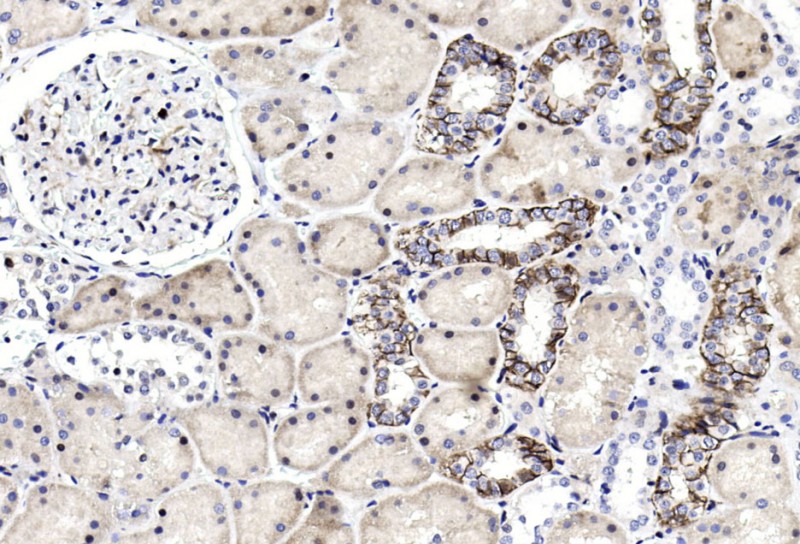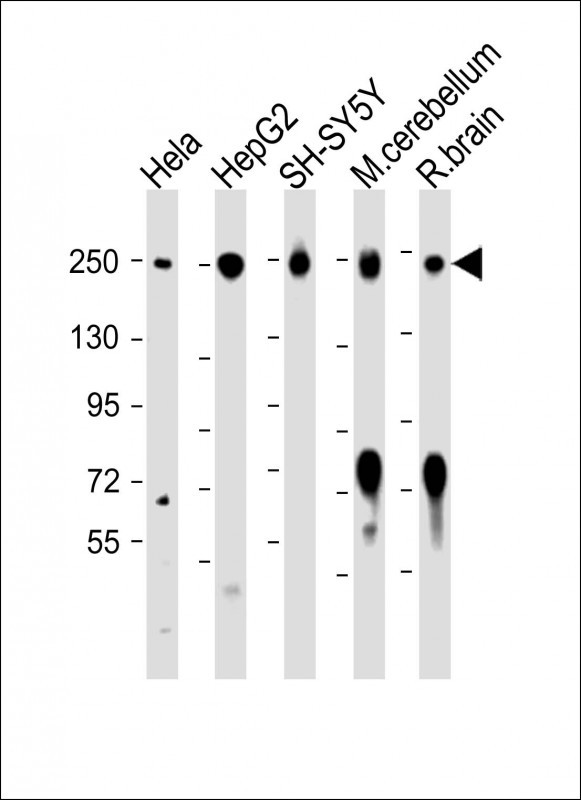L1CAM Antibody (C-term)
Affinity Purified Rabbit Polyclonal Antibody (Pab)
- 产品详情
- 实验流程
- 背景知识
Application
| IHC-P, WB, E |
|---|---|
| Primary Accession | P32004 |
| Other Accession | Q05695, P11627, NP_001137435.1 |
| Reactivity | Human, Rat, Mouse |
| Predicted | Rat |
| Host | Rabbit |
| Clonality | Polyclonal |
| Isotype | Rabbit IgG |
| Calculated MW | 140003 Da |
| Antigen Region | 1154-1182 aa |
| Gene ID | 3897 |
|---|---|
| Other Names | Neural cell adhesion molecule L1, N-CAM-L1, NCAM-L1, CD171, L1CAM, CAML1, MIC5 |
| Target/Specificity | This L1CAM antibody is generated from rabbits immunized with a KLH conjugated synthetic peptide between 1154-1182 amino acids from the C-terminal region of human L1CAM. |
| Dilution | IHC-P~~1~600 WB~~1:2000 E~~Use at an assay dependent concentration. |
| Format | Purified polyclonal antibody supplied in PBS with 0.05% (V/V) Proclin 300. This antibody is purified through a protein A column, followed by peptide affinity purification. |
| Storage | Maintain refrigerated at 2-8°C for up to 2 weeks. For long term storage store at -20°C in small aliquots to prevent freeze-thaw cycles. |
| Precautions | L1CAM Antibody (C-term) is for research use only and not for use in diagnostic or therapeutic procedures. |
| Name | L1CAM |
|---|---|
| Synonyms | CAML1, MIC5 |
| Function | Neural cell adhesion molecule involved in the dynamics of cell adhesion and in the generation of transmembrane signals at tyrosine kinase receptors. During brain development, critical in multiple processes, including neuronal migration, axonal growth and fasciculation, and synaptogenesis. In the mature brain, plays a role in the dynamics of neuronal structure and function, including synaptic plasticity. |
| Cellular Location | Cell membrane; Single-pass type I membrane protein {ECO:0000250|UniProtKB:Q05695}. Cell projection, growth cone {ECO:0000250|UniProtKB:Q05695}. Cell projection, axon. Cell projection, dendrite Note=Colocalized with SHTN1 in close apposition with actin filaments in filopodia and lamellipodia of axonalne growth cones of hippocampal neurons (By similarity). In neurons, detected predominantly in axons and cell body, weak localization to dendrites (PubMed:20621658) {ECO:0000250|UniProtKB:Q05695, ECO:0000269|PubMed:20621658} |
For Research Use Only. Not For Use In Diagnostic Procedures.
Provided below are standard protocols that you may find useful for product applications.
BACKGROUND
L1CAM is an axonal glycoprotein belonging to the immunoglobulin supergene family. The ectodomain, consisting of several immunoglobulin-like domains and fibronectin-like repeats (type III), is linked via a single transmembrane sequence to a conserved cytoplasmic domain. This cell adhesion molecule plays an important role in nervous system development, including neuronal migration and differentiation. Mutations in the gene cause three X-linked neurological syndromes known by the acronym CRASH (corpus callosum hypoplasia, retardation, aphasia, spastic paraplegia and hydrocephalus). Alternative splicing of a neuron-specific exon is thought to be functionally relevant.
REFERENCES
Schafer, M.K., et al. FEBS Lett. 584(21):4475-4480(2010)
Bailey, S.D., et al. Diabetes Care 33(10):2250-2253(2010)
Bertolin, C., et al. J. Neurol. Sci. 294 (1-2), 124-126 (2010) :
Schafer, M.K., et al. Cell. Mol. Life Sci. 67(14):2425-2437(2010)
Gavert, N., et al. J. Cell. Sci. 123 (PT 12), 2135-2143 (2010) :
终于等到您。ABCEPTA(百远生物)抗体产品。
点击下方“我要评价 ”按钮提交您的反馈信息,您的反馈和评价是我们最宝贵的财富之一,
我们将在1-3个工作日内处理您的反馈信息。
如有疑问,联系:0512-88856768 tech-china@abcepta.com.























 癌症的基本特征包括细胞增殖、血管生成、迁移、凋亡逃避机制和细胞永生等。找到癌症发生过程中这些通路的关键标记物和对应的抗体用于检测至关重要。
癌症的基本特征包括细胞增殖、血管生成、迁移、凋亡逃避机制和细胞永生等。找到癌症发生过程中这些通路的关键标记物和对应的抗体用于检测至关重要。 为您推荐一个泛素化位点预测神器——泛素化分析工具,可以为您的蛋白的泛素化位点作出预测和评分。
为您推荐一个泛素化位点预测神器——泛素化分析工具,可以为您的蛋白的泛素化位点作出预测和评分。 细胞自噬受体图形绘图工具为你的蛋白的细胞受体结合位点作出预测和评分,识别结合到自噬通路中的蛋白是非常重要的,便于让我们理解自噬在正常生理、病理过程中的作用,如发育、细胞分化、神经退化性疾病、压力条件下、感染和癌症。
细胞自噬受体图形绘图工具为你的蛋白的细胞受体结合位点作出预测和评分,识别结合到自噬通路中的蛋白是非常重要的,便于让我们理解自噬在正常生理、病理过程中的作用,如发育、细胞分化、神经退化性疾病、压力条件下、感染和癌症。







